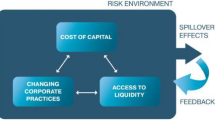Abstract
The real estate literature recognizes the real option to invest in capital expenditures (CAPEX) or sell a property but treats these options as independent. We show that these real options are interconnected. We provide empirical evidence that, consistent with the real option framework, CAPEX increases in income growth expectations but declines in their volatility; that CAPEX are partially capitalized into property market values; and that CAPEX significantly reduce the subsequent likelihood of sale. We also present evidence that, controlling for market timing, past property performance influences CAPEX but not disposition choices, consistent with a value-add investment strategy.


Similar content being viewed by others
Notes
We assume that leases are reviewed or renewed so that rents can be reset to the prevailing market level.
Those represent accounting anomalies where excess reserves for CAPEX projects were booked and then reversed when the actual cost of the projects was revealed.
It is important to note that we do not consider routine repairs and maintenance, which would fall under operating expenses, nor tenant incentives and lease commissions.
It is possible for a property to be bought and subsequently sold quickly, potentially within the same year. There are no instances of “flipping” properties in our final sample.
These results are robust to the inclusion of a variable that measures the time since acquisition. However, the homogeneous and low baseline likelihood of sale in the NCREIF data works against us establishing empirical evidence for a significant relationship between CAPEX and subsequent disposition; as a result our estimates can be regarded as conservative.
References
Barthélémy, F., & Prigent, J.-L. (2009). Optimal time to sell in real estate portfolio management. Journal of Real Estate Finance and Economics, 38(1), 59–87.
Bertola, G. (1998). Irreversible investment. Research in Economics, 52(1), 3–37.
Bokhari, S. (2016). Characteristics of depreciation in commercial and multifamily property: an investment perspective. Real Estate Economics, Forthcoming.
Bokhari, S., & Geltner, D. (2011). Loss aversion and anchoring in commercial real estate pricing: empirical evidence and price index implications. Real Estate Economics, 39(4), 635–670.
Bond, S., Shilling, J.D., Wurtzebach, C.H. (2014). Commercial real estate market property level capital expenditures: an options analysis. Discussion paper, RERI Working Paper.
Chinloy, P., Hardin, W., Wu, Z. (2013). Transaction frequency and commercial property. Journal of Real Estate Finance and Economics, 47(4), 640–658.
Collett, D., Lizieri, C., Ward, C. (2003). Timing and the holding periods of institutional real estate. Real Estate Economics, 31(2), 205–222.
Crane, A.D., & Hartzell, J.C. (2010). Is there a disposition effect in corporate investment decisions? Evidence from real estate investment trusts, Working Paper.
Dixit, A.K., & Pindyck, R.S. (1994). Investment under uncertainty. Princeton University Press.
Fisher, J., Gatzlaff, D., Geltner, D., Haurin, D. (2004). An analysis of the determinants of transaction frequency of institutional commercial real estate investment property. Real Estate Economics, 32(2), 239–264.
Genesove, D., & Mayer, C. (2001). Loss aversion and seller behavior: evidence from the housing market. Quarterly Journal of Economics, 116(4), 1233–1260.
Ghosh, C., & Petrova, M. (2015). The impact of capital expenditures on property performance in commercial real estate. Journal of Real Estate Finance and Economics, Forthcoming.
Ling, D., & Petrova, M. (2015). The economic impact of repealing or limiting section 1031. Like-kind exchanges in real estate, Working Paper.
Munneke, H.J., & Womack, K.S. (2017). Valuing the redevelopment option component of urban land values. Real Estate Economics, Forthcoming.
Peng, L., & Thibodeau, T.G. (2011). Interest rate and investment under uncertainty: evidence from commercial real estate capital expenditures. Discussion paper, RERI Working Paper.
Pindyck, R.S. (1988). Irreversible investment, capacity choice, and the value of the firm. American Economic Review, 78(5), 969–985.
Acknowledgments
We are thankful for comments from James Conklin, Robert Connolly, David Geltner, David Ling, Crocker Liu, Joseph Ooi, Tim Riddiough, Jacob Sagi, Stijn Van Nieuwerburgh, and Susan Wachter, as well as an anonymous referee, seminar participants at the RERI Research Conference 2017, the AREUEA National Meeting 2017, the ASSA Annual Meeting 2018, and the University of Florida–Cambridge–National University of Singapore Real Estate Symposium 2018. We gratefully acknowledge financial support from the Real Estate Research Institute (RERI). We are also grateful to the National Council of Real Estate Investment Fiduciaries for providing data.
Author information
Authors and Affiliations
Corresponding author
Additional information
Publisher’s Note
Springer Nature remains neutral with regard to jurisdictional claims in published maps and institutional affiliations.
Rights and permissions
About this article
Cite this article
Ambrose, B.W., Steiner, E. Economic Fundamentals, Capital Expenditures and Asset Dispositions. J Real Estate Finan Econ 64, 361–378 (2022). https://doi.org/10.1007/s11146-019-09698-9
Published:
Issue Date:
DOI: https://doi.org/10.1007/s11146-019-09698-9




